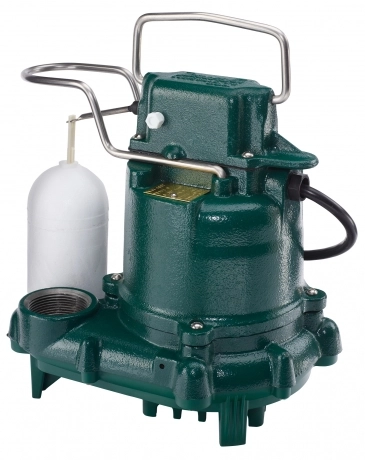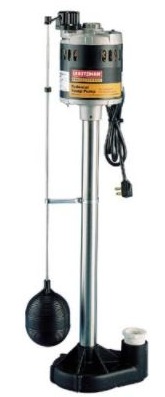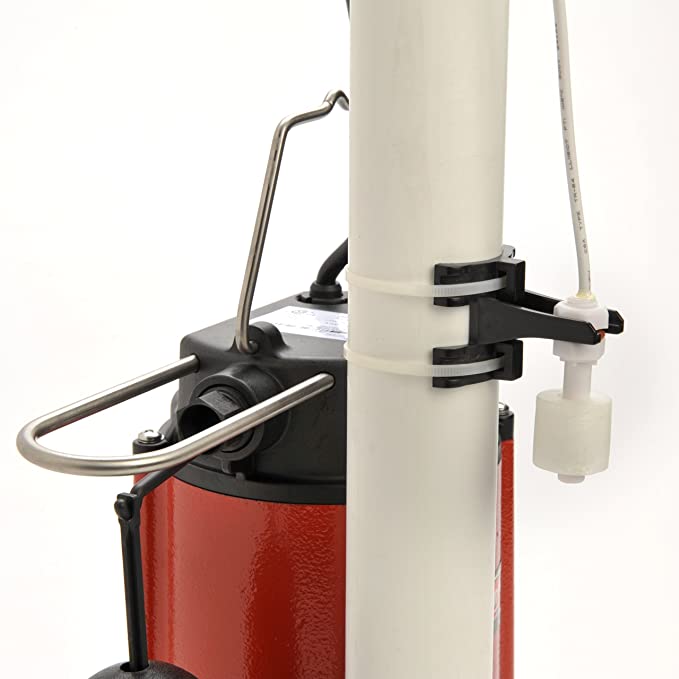A sump pump helps keep excess groundwater or rainwater from entering your home and causing water damage. The information that follows can help you maintain your sump pump, protect your home, and keep it in working condition.
What Is It?
Depending on the age of your home and the region of the country you live in, you may or may not have a sump pump. A sump pit is a basin situated in the basement or crawlspace that has a submersible or pedestal water pump. The pit collects groundwater or floodwater before the motor pumps it out to a suitable discharge area. This collection pit sits below the floor and has a lid on the top. Your home may have a perimeter drain system around the foundation that drains to this pit.
The pit cover is often sealed with sealant for moisture and radon concerns. The submersible pump (most common) in the pit has an integral float that triggers the pump’s motor whenever the water level reaches a certain height to prevent flooding. The pump’s motor then starts pumping out excess water. As the water levels drop, the switch also goes down and the pump shuts off at a certain point. The float also ensures that the sump pit cannot overflow except during extreme circumstances.
Common Design Courtesy of Zoeller Pumps - Zoeller Series 50 Submersible Pump
Types of Pumps
Pedestal sump pumps sit above the water line and are not designed to get wet. Since they are not contained within the sump pit, they can be accessed easily but are also very noisy. They cost roughly $60 to $200, which is significantly less than other varieties.
Pedestal
Submersible sump pumps rest underwater at the bottom of the sump pit and are much quieter than pedestal pumps. Their oil-cooled motors and tight seals protect against water and dust and afford them a long lifespan. They can cost up to $600.
Water-powered sump pumps are normally used as backups and kick in when the main pump experiences an electrical or mechanical failure. They can cost up to $800.
How is it powered?
The pump is plugged into a minimum of a 15 amp circuit. It may be on a dedicated circuit but that is not required. Be sure this circuit does not also power an appliance, i.e., a refrigerator or freezer, as this may be too much of a load. The latest 2020 edition of the National Electrical Code (NEC) has expanded the requirement for GFCI protection to include both finished and unfinished basements. Hence, the usual location of a sump pump in the basement would require a GFCI-protected circuit.
GFCI outlets work by detecting sudden spikes in the electrical system they protect. If an appliance suddenly suffers a ground fault or other accident, the GFCI turns off the electrical supply instantaneously. This can protect you and your family from unexpected shocks.
However, some equipment such as a sump pump that starts automatically and draws a very high load on startup may fool the GFCI causing a nuisance trip. The problem is an undetected GFCI interrupt when the pump is most needed. A GFCI interrupt during heavy rain can quickly cause your basement to flood. This can be disastrous, especially if it happens when you aren’t at home. This is the main reason many experts recommend that sump pumps not be plugged into a GFCI-protected outlet, however it is required by the electrical code. Check with your local building department to see if a GFCI is required in your area.
Basement System
Inspect the System
At a minimum, you should inspect the sump pump system annually. Below are additional recommendations from the Sump & Sewage Pump Manufacturers Association (SSPMA) and their 2013 Guide.
Monthly: If your pump disposes of water from a washing machine, a monthly cleaning of the pump screen or inlet opening may be needed. The SSPMA also advises that the pump should be unplugged before cleaning — but make sure it's plugged back in upon completion.
Quarterly: If your pump does not dispose of washing machine water, the pump screen or inlet opening can be cleaned once every three to four months.
Annually: Remove the submersible pump and clean both the pump and pit. Follow the pump manufacturer's information on cleaning the pump. Many have lifetime lubrication and require little to no maintenance.
If this maintenance is outside your comfort zone and you decide to hire a professional, consult with a professional plumber. Here are six things a professional should examine during an annual inspection of a sump pump.
1. The pit. A pump sits in a pit that gathers and collects water until the pump removes it. A professional should ensure that the pit is large enough — at least 24 inches deep and 18 inches wide, says the International Association of Certified Home Inspectors (InterNACHI) — for the sump pump to function properly.
2. The check valve. A professional should make sure that there is a functioning check valve installed on the discharge pipe. The check valve helps prevent water in the discharge pipe from flowing back down into the pit after the pump turns off.
3. A backup power source. Sump pumps may need to work harder during extreme weather conditions where heavy rains may result in power outages. A professional can confirm whether or not there is a battery backup power source on a sump pump, such as a battery, and that it is in proper working condition.
4. The alarm. While not all sump pumps are required to have alarms that sound when the device is activated, they can help alert a homeowner that there is water buildup in the pit. If a sump pump has one, it should be tested to help ensure it functions properly.
Pump Alarm Sensor
5. The cover. Since sump pump pits collect water, they should have a removable cover to help prevent water from evaporating into the basement. A professional will ensure it fits properly or should help add one if needed.
6. The discharge location. A professional can alert homeowners if their pump's discharge location is improper. It is recommended that the discharge location be at least 20 feet away from the home to help prevent water from draining back towards the house — and it should not drain onto neighboring properties, into public sewer systems, or into a residential septic system. This distance can be a problem with small lots, as we tend to use all the lot for today's homes with small space between homes. The key is having a sufficient amount of slope from the discharge point. Most new homes today drain to the lot line between properties.
Discharge
Conclusion
If you have a sump pump be sure to add this maintenance to your regular schedule of home maintenance. A little time and effort can help you save a lot of expenses later and potential damage to your home.









